Sand Castles in War Zones
Insanity and Forgiveness
What defines a person when all the chips are down and past and present are stripped away? Daniel Talbott’s play, metaphorically titled Afghanistan, Zimbabwe, America, Kuwait (AZAK) that concluded its run at the Judson Gym on June 27, 2015, unpacks this question in the guise of a contemporary soldier’s story in an undefined desert location delivered in carefully choreographed beats.
The first surprise is our narrator, a pained unnamed Serbian woman (Jelena Stupljanin) who enters in half-light to spin a horrific tale in the play’s initial monologue. For a while her words pull us off center: she speaks in Serbian for a few minutes before concluding her remarks in English to state absolutely clearly: soldiers killed her family, raped her repeatedly, and refused to kill her.
They raped me every day. They took me to the soldiers and back to the house. Some days it lasted two hours. Some days until morning. The only conversation we had was when I was begging them to kill me. That’s when they laughed. Their response was, “We don’t need you dead.”
Next, we meet several US soldiers in the relentless desert glare—they inhabit the barren place as recent arrivals who expect to be leaving soon. Smith (Seth Numrich) and Leadem (Brian Miskell) have billeted in this bleak outpost for a week or so to await further orders and supplies, and Miller (Chris Stack) who comes along a bit later, is similarly bereft of supplies and the rest of his company. The month or so of the play’s action wears at the men and on us.
We expect this to be a story of survival, male camaraderie—wrestling, jokes, and war time extremes—yet Talbott has other plans for his narrative. Smith conjures an imaginary mother he refers to as Leadem’s mom (Kathryn Erbe) and Leadem recalls his younger brother (Jimi Stanton) and misses simple acts of brotherly affection and competition. Are these ghosts or hallucinations? Have we entered another world? Talbott leaves us to decide. “If you believe in ghosts, they’re ghosts. If you believe in hallucination and science, they’re hallucination and science, or dream life.”
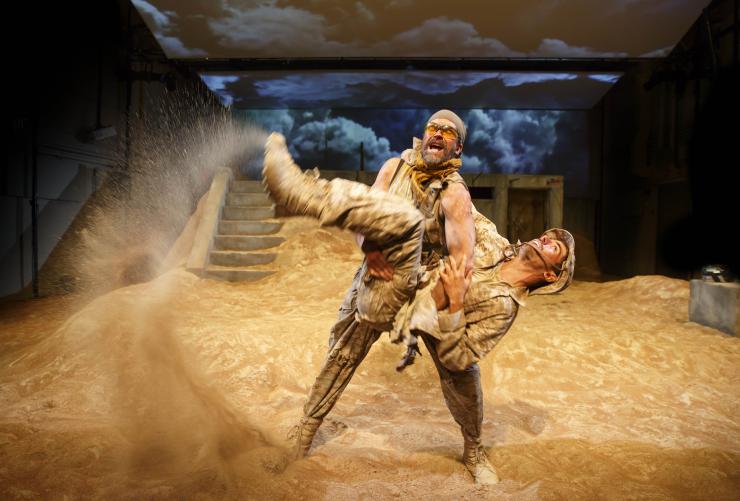
Two unnamed soldiers (Andy Striph and Stephen Dexter) complete several tableaus in full army regalia, as a kind of soldier chorus. Performances are agile and smart, blending devastating contemporary meetings among the soldiers, memories, fantasies, and hallucinations with bravado, sadness, and exhaustion in equal measure. And then there is the Serbian woman who begins our tale—what to make of her? The journey of this play is in the answer to this final question.
Impulse for the Play: Subways are not for Sleeping
Daniel Talbott, playwright and director for this production, is also an actor, dramaturg, and literary manager, and works in film, stage, and television. The role and the medium may vary from project to project, but his intensity, commitment, investment, and heart (people always mention heart) dominate any project in which he is involved.
A subway realization three years ago led him to ponder the themes that animate AZAK.
I very specifically wanted to write about military war. I felt so detached myself from it, and I was really angry at myself for feeling that way. I don’t agree with war but I absolutely support the people who are making my life possible. I’m very pro soldier. I started researching a bunch of different wars.
He was angry at his own lack of awareness.
All of our luxury and our privilege come on the back and misery of someone else. Everything we do. Someone is getting their fucking head blown off right now and I haven’t thought about it for two months. I try to think about interconnectedness, in the theatre and with everything we do.
On Structure and Impact
This kind of storytelling reveals itself in layers. Our initial instincts to find logic and flow are thwarted in Talbott’s creation by competing narratives and characters we know aren’t alive.
Confusion for the characters is something Talbott says he want to share with his audiences.
It’s not meant to be a well-made play. I didn’t want it to be facts and interviews with soldiers. I wanted you to have to sit in the sand with these people. That’s what I kept saying to myself. I knew I wanted you to have to sit in a room with those people, not have it explained. It’s meant to be as confusing for us as it is for them.
Talbott wants everyone to work—His ninety-minute adventure has quick cuts interspersed with longer scenes, but the trudge is an inexorable one. The play sets a defiant context and tone. “The play is unapologetic. It’s nasty, it’s violent, and it’s not trying to be friendly.” It’s also gentle.
You just get a bigger picture when you step back from it, and I knew I wanted the play to honor that. I knew I didn’t want to explain anything and I didn’t want to give facts, I wanted it to be experiential. That’s why Leadem talks about a barbecue at one point. I wanted you to feel like that’s what he misses at the end, hearing his neighbors at a barbecue, smelling a girl’s hair.
And at the same time, Talbott invokes the ship of fools allegory (used in philosophy and literature from Plato to Katherine Anne Porter) of a vessel inhabited by human characters traveling without anyone at the helm.
I didn’t want it to be facts and interviews with soldiers. I wanted you to have to sit in the sand with these people. That’s what I kept saying to myself. I knew I wanted you to have to sit in a room with those people, not have it explained. It’s meant to be as confusing as it is for them.
Talbott contends the story asked for the kind of chaotic structure he used. “I don’t know how, as a person or an artist, I could write a play that was fun or light or frolicky or well-meaning and well-made. War is messy. What we’re doing is messy. I wanted to write a play that honored by experience, of the shit that’s going on in this country.” And the rhythm and pacing of the piece are essential.
I knew the play was a countdown towards something, as I feel we’re kind of counting down towards something and we’re not really heeding that countdown. Tableaus are always the same rhythm. They’re metronomic; they move us forward consistently towards something. I wanted it to mimic life, but always being forced forward, whether the characters wanted to be or not. I knew the structure worked that way for me.
Talbott strives for work that punctures and ruptures the participants—performers and audience members alike. “Theatre to me is all about being permeated. Why else be in a room with somebody if you’re not going to be permeated.”
On the Play’s Physical World
Raul Abrego’s set creates a desiccated environment for this desiccated story. Dust clouds bring you right into the action, into the story, into the beat. Beige brick walls of the familiar subterranean Judson performance space blend into the sand piles that define this world, lapping outward from the edges of the playing area toward audience members, who crunch grains underfoot on their way to their seats. A fragmented set of cement stairs in the playing area raises questions; was this once a bunker, or was this a dwelling? The desert subsumes whatever was here.
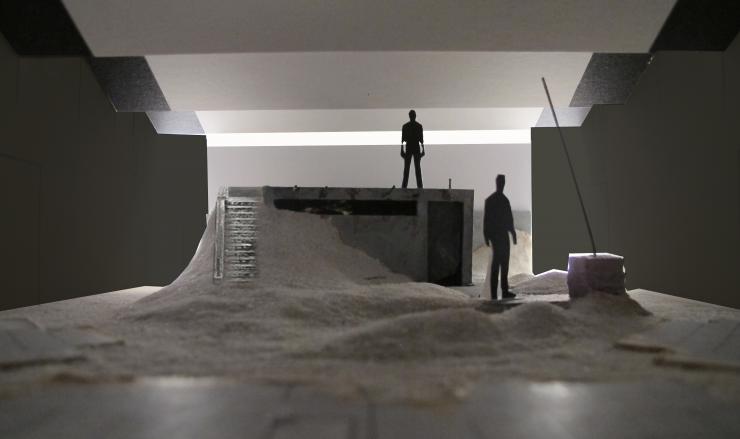
Rattlestick Playwrights Theater and piece by piece productions had not produced in this location before. “It was all about the space,” Talbott recalled. The fact that we see, touch, and breathe this world as created in the Judson Gym, exerts a powerful effect on audience members whose airways gradually dry out. With grains of sand crunching underfoot, Talbott’s experiential theatre theme resonates. “I’m more and more obsessed with how we experience theatre, not how we think about theatre. I want theatre to hit me in my head last. I want it to hit me in my body and my heart and my ninth sense—the part of you that believes in imagination.”
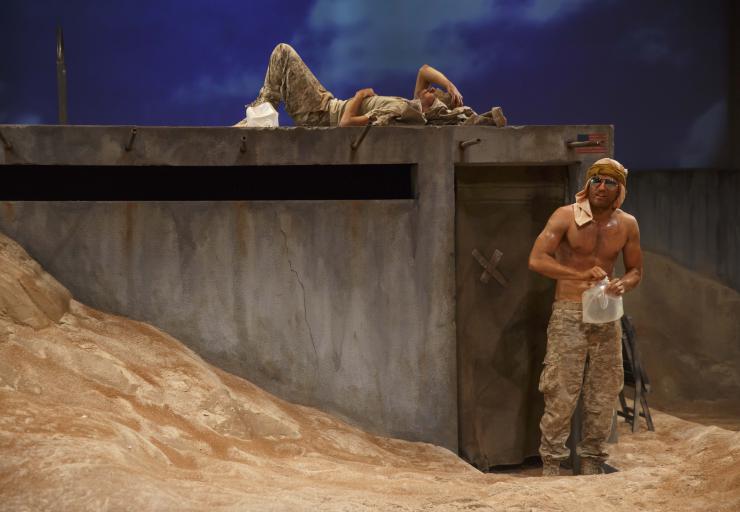
Collegial Reflections on Talbott’s Heart and Generosity of Spirit
Talbott’s good friend Estelle Parsons saw the show twice, and responded to some email questions while in rehearsals for Off the Main Road at the Williamstown Theatre Festival. Her enchantment, it seems, is both with the topic and Daniel’s style. “I am captivated by the way actors throw their entire beings into the plays Dan brings to the stage.” She sees the war weary world that we live in. “It is so difficult if not impossible to look beyond the horrors we are all contemplating for our sons, lovers, and fathers who are waging the wars everywhere.” Daniel, she contends, seeks the deepest questions of human existence.
Daniel is contemplating life and death and how it reduces us to an elemental state of expression—the niceties are gone, the niceties that can only exist in safe situations, and we see there are not so many notes to play, not so many complications of expression of personality available to us when we do not have the situation of peace and food in our bellies and safety. What do we have when we are beyond civilization and civilized behavior?
I tell Talbott that my journey seeing his production was releasing myself into the world of the play. Talbott connects me to his friend playwright Lucy Thurber who had that kind of experience. Watching this play, she tells me, exploded how she has been taught to read and experience plays. She started in for the logical analytic slog we’re taught to engage in: who is who, where are we, and what’s the logic of this world. “At one point I just said, Fuck it, I want to go on the ride and I did.” She finds the experience is still alive for her, some weeks after seeing the production. “It reminded me that there are lots of ways to have an experience.” She also underscored the moment of audience choice. “I could have chosen not to go on the ride—there was a point at which I needed to say yes and turn over the reins.” She’s still musing about “not the plot of it but the story of it.”
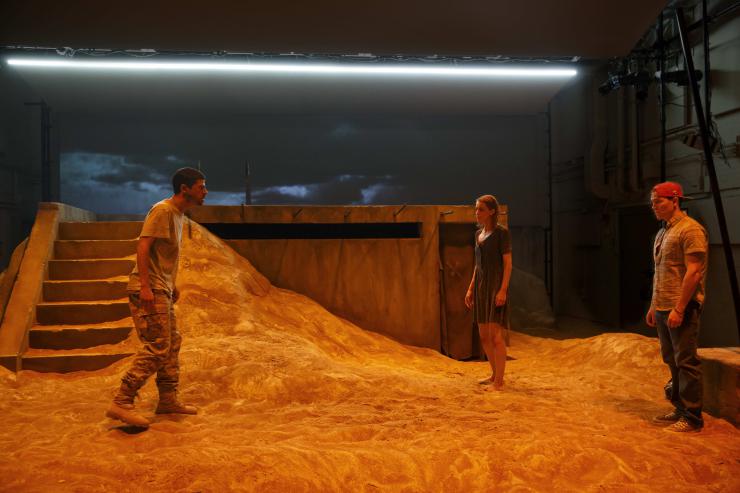
Voices and Endings
Our narrator’s tale in AZAK is the context for this piece. From her death following wartime abuse at the hands of the soldiers, we ponder the depths of human despair, the boundaries of human action, and the resonance of forgiveness.
Forgiveness is the entire play for me, and how do you forgive, how do you honor. Because in the end the only way you’re ever going to change anything is through kindness and forgiveness.
The journey from first to last moments in this play is surprising and spare, joyous and devastating. Our narrator disappears until the end of the countdown toward resolution—her journey to resonant forgiveness. For the men we meet along the way, that resolution is plot and biology: can humans survive without food and water in a desert wasteland?
Talbott knew the ending before the rest of it.
I knew the end of the play I think before I knew anything else. I knew that she [Serbian Woman] would be with Leadem at the end because I wanted to look at how you forgive people. Forgiveness is the entire play for me, and how do you forgive, how do you honor. Because in the end the only way you’re ever going to change anything is through kindness and forgiveness. And how do you forgive someone who’s done these things? How do you forgive someone who’s killed your family? She probably would have done the same thing if she were in their position; her country would have done the same thing to them. I feel like she really honors that. She never says I forgive you, ever. But she says: I’ll be your friend and you need me here.
Where our narrator takes us is toward a vision of hope. She has the final words: “Everything bad is gone now. We begin to fall forward. To something better.”
We both need and embrace her life lesson. What defines a person in that “chips are down” scenario? In this play and perhaps in the universal condition, we say: forgiveness and the possibility of a new day.


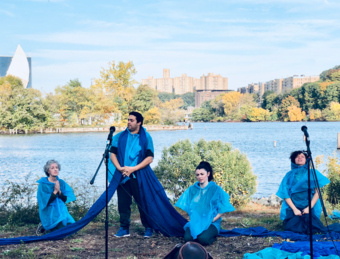



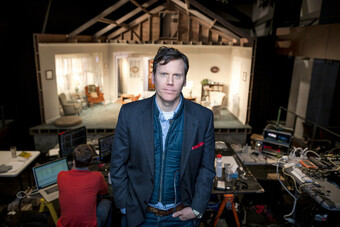
Comments
The article is just the start of the conversation—we want to know what you think about this subject, too! HowlRound is a space for knowledge-sharing, and we welcome spirited, thoughtful, and on-topic dialogue. Find our full comments policy here
Yes, I loved this play! I saw it and thought, this is what I want in theatre -- an event that makes me larger than I was when I got here. As a playwright and dramaturg, I am also trying to piece together the world thru the hits I take off my own personal feed, so I don't necessarily value making sense -- I value the opportunity to make someone else's sense and to try to create structures, like the one Talbott makes, to provide a path to the satisfaction we take in making meaning, especially with horror (the Serbian woman or the dolphin for instance) because we are all participating in our world, like it or not.